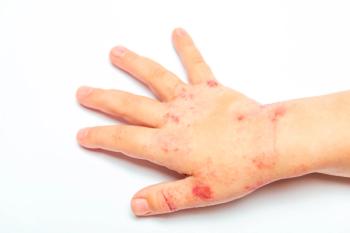
Sacrococcygeal Pilonidal Sinus
The cause was pilonidal sinus disease. The term pilonidal is derived from the Latin words "pilus," meaning "hair," and "nidus," meaning "nest." Pilonidal sinus disease is more common in males than in females and typically appears during adolescence. About 1% of all males and 0.1% of all females have an asymptomatic pilonidal sinus with potential for disease.1 The suspected overall incidence is about 1 in 5000. The disease seems to be most prevalent in those with stiff, dark or auburn hair, although it has been observed in all races.2
FigureA 16-year-old boy had a painful swelling in his gluteal cleft for several days that was accompanied by yellow-brown staining of his shirttail and underwear. A year earlier, he had a similar discharge on his shirt that corresponded to an area near the buttocks.
The cause was pilonidal sinus disease. The term pilonidal is derived from the Latin words "pilus," meaning "hair," and "nidus," meaning "nest." Pilonidal sinus disease is more common in males than in females and typically appears during adolescence. About 1% of all males and 0.1% of all females have an asymptomatic pilonidal sinus with potential for disease.1 The suspected overall incidence is about 1 in 5000. The disease seems to be most prevalent in those with stiff, dark or auburn hair, although it has been observed in all races.2
Some experts contend that sacrococcygeal pilonidal sinus disease is congenital-a caudal remnant in the neural canal remains adherent to the cutaneous surface and forms small cysts, which later rupture and cause blind-ended sinuses. However, the disease is commonly thought to be acquired-because of the higher prevalence among men, its appearance in adolescence, and its association with nonhereditary risk factors (such as obesity, personal hygiene, and sedentary occupation). 1 In addition, similar lesions have been observed in other parts of the body, including the hands and male genitalia.
The disorder begins as loose hair, leading with the root end, collects in the natal cleft. Frictional forces cause the hair to penetrate the skin. The collection of hairs provokes a foreign-body reaction and eventual infection.3
Primary sinuses are thought to be caused by the initial entry of hair into the skin; secondary fistulas and cavities are the portals where the hair traverses and exits. The primary sinus is usually lined by a stratified squamous epithelium, and the cyst cavities are lined by chronic granulation tissue, hair shafts, epithelial debris, and immature granulation tissue. The deeper sinus area subsequently becomes invaded by neutrophils, lymphocytes, plasma cells, and macrophages. Roughly three quarters of such sinuses are colonized by anaerobic bacteria, about 4% by aerobic bacteria, and about 17% by both aerobic and anaerobic bacteria.4 The cause of these distorted hair follicles is unknown. One theory is that the combination of gravity and motion of the gluteal folds creates a vacuum, which pulls on the follicles.3
Patients with a pilonidal abscess in the sacrococcygeal region present with pain, erythema, and swelling. Often their discomfort increases after physical activity or a long period of sedentary activity (eg, a long car drive).
No treatment is necessary for asymptomatic abscesses. Treatment options for symptomatic abscesses are listed in the Table. The healing rate for manual drainage/aspiration and antibiotics or for drainage with curettage and antibiotics is about 60%, with rapid return to normal activity and relief of symptoms. However, recurrence is as high as 25% with these treatments. Abscesses that continue to recur after 6 months often require a definitive surgical procedure. The cure rate is higher and recurrence is minimal with surgery.2
Table
This patient underwent manual drainage of the abscess, and he was given clindamycin. Primary closure will be considered if the abscess recurs.
References:
- Silva JH. Pilonidal cyst: cause and treatment. Dis Colon Rectum. 2000;43:1146-1156.
- Hull TL, Wu J. Pilonidal disease. Surg Clin North Am. 2002;82:1169-1185.
- Bascom J. Pilonidal disease: long-term results of follicle removal. Dis Colon Rectum. 1983;26:800-807.
- Chintapatla S, Safarani N, Kumar S, Haboubi N. Sacrococcygeal pilonidal sinus: historical review, pathological insight and surgical options. Tech Coloproctol. 2003;7:3-8.
Newsletter
Access practical, evidence-based guidance to support better care for our youngest patients. Join our email list for the latest clinical updates.








